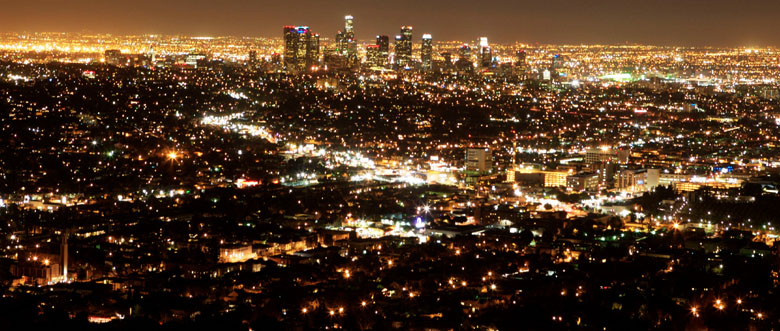
Bright city lights exacerbate air pollution
By Jane Palmer
The bright city lights of Los Angeles might attract aspiring movie stars, but according to CIRES scientist Harald Stark, they also contribute to one of the area’s less favorable claims to infamy: air pollution.
“It turns out the light reduces the amount of air- cleansing agents at night,” said Stark, who made this discovery on several nighttime research flights over the city in 2010 to measure air pollution levels and light intensities.
Each day, pollution from car tailpipes and factory towers pours into the air surrounding cities. Then each night a process in the atmosphere cleans up some of this murky mess: A chemical called a nitrate radical breaks down the chemicals that would otherwise have formed smog and ozone. But this wonder chemical only works in the dark because sunlight destroys it. And so, it turns out, does the glare from bright city lights.
“The lights may be 10,000 times dimmer than the sun, but the effect is still significant,” Stark said. “And
The Science
The atmosphere’s nighttime janitors—nitrate radicals—scrub the air clean of pollutants emitted during the day. But city lights can destroy these chemical cleansers, resulting in higher daytime ozone levels.
it is important because it has the potential of influencing daytime pollution levels.”
Stark’s measurements indicated the energy of the nighttime lights slowed down nighttime cleansing by up to 7 percent and also increased the starting chemicals for ozone pollution the next day by up to 5 percent.
Fortunately, alternatives to turning the lights out to prevent their damaging effects do exist, Stark said. If more urban lights were pointed to the ground instead of toward the stars, less light would permeate the atmosphere, he said. “It is more efficient for cities to do that because they don’t want to
illuminate the sky,” he said. “They want to illuminate the cities themselves.”
One other, less practical, alternative also exists. Red lights don’t destroy the radical to the same extent as the high-pressure sodium lights and metal halide lights that dominate city lighting. If cities replaced their current lights with red lights, they could mitigate the damage to the nitrate radical, Stark said. “But turning our cities red doesn’t sound like a good idea,” he said.
The phenomenon of urban lighting destroying the nocturnal cleaning agent is in no way unique to the bright lights of Los Angeles, Stark said. “L.A. is not the brightest spot in the U.S.,” he said. “Las Vegas is brighter, and some of the East Coast cities are brighter too.” The next goal of this research would be to investigate the effects of nighttime lights on cities in both the U.S. and worldwide, he said. “Many cities are close to their regulatory limits in terms of ozone levels,” he said. “So even a small effect such as this could be important.”


